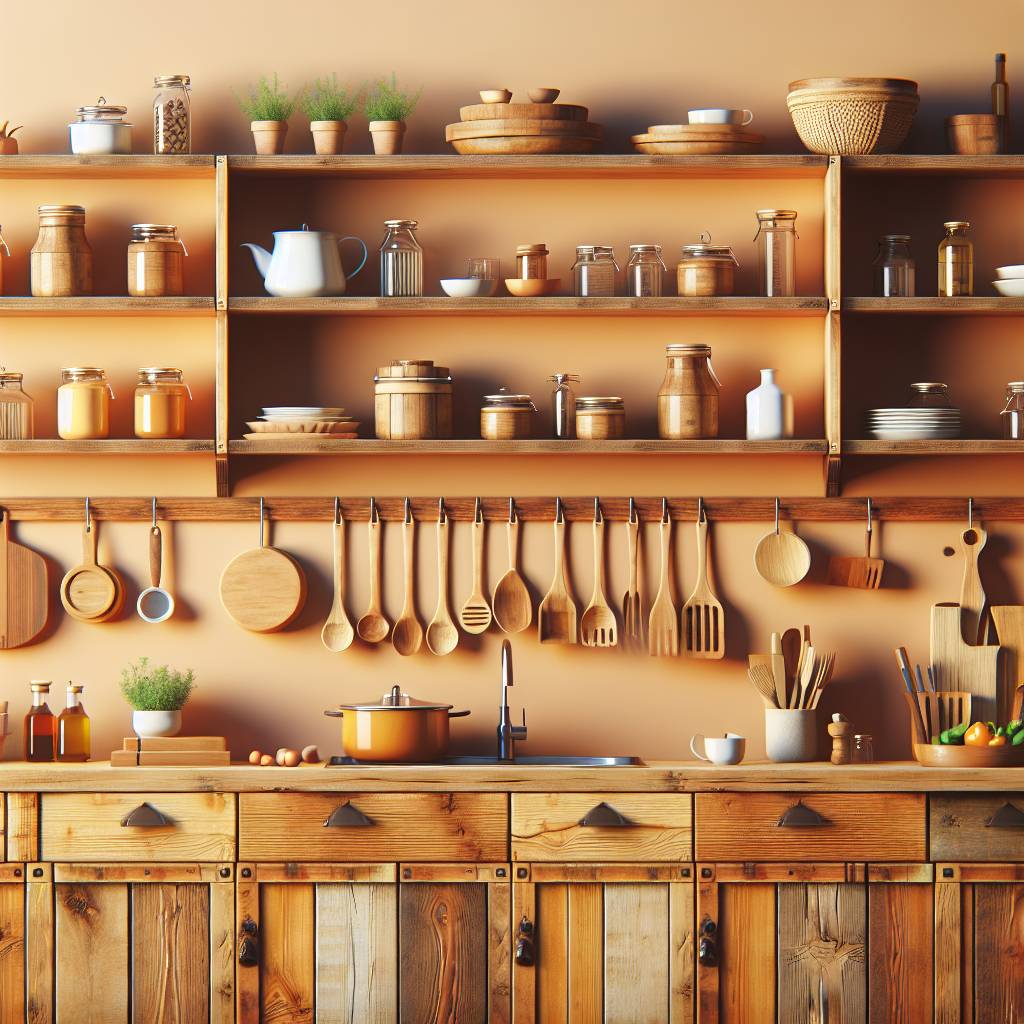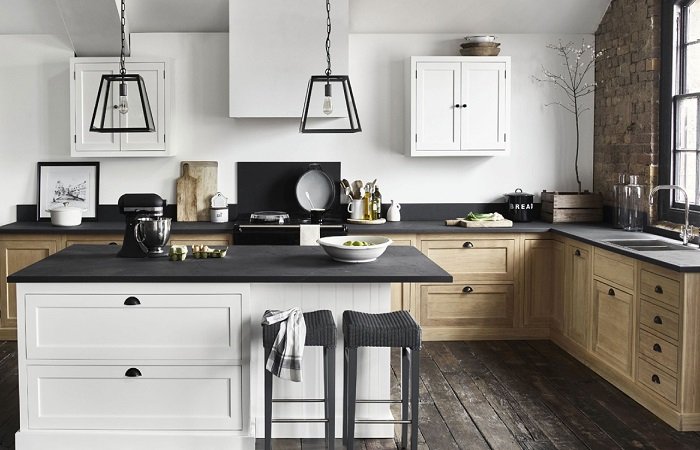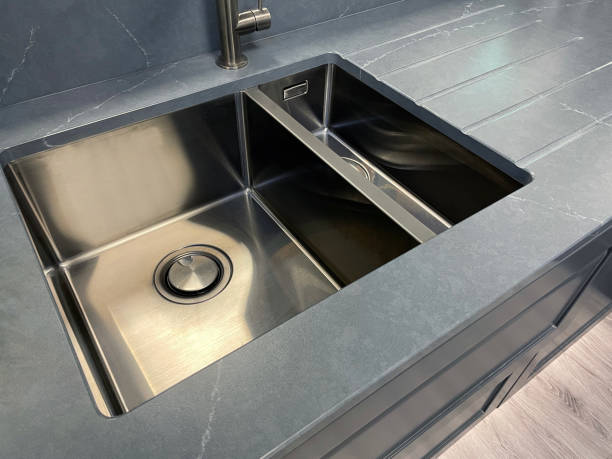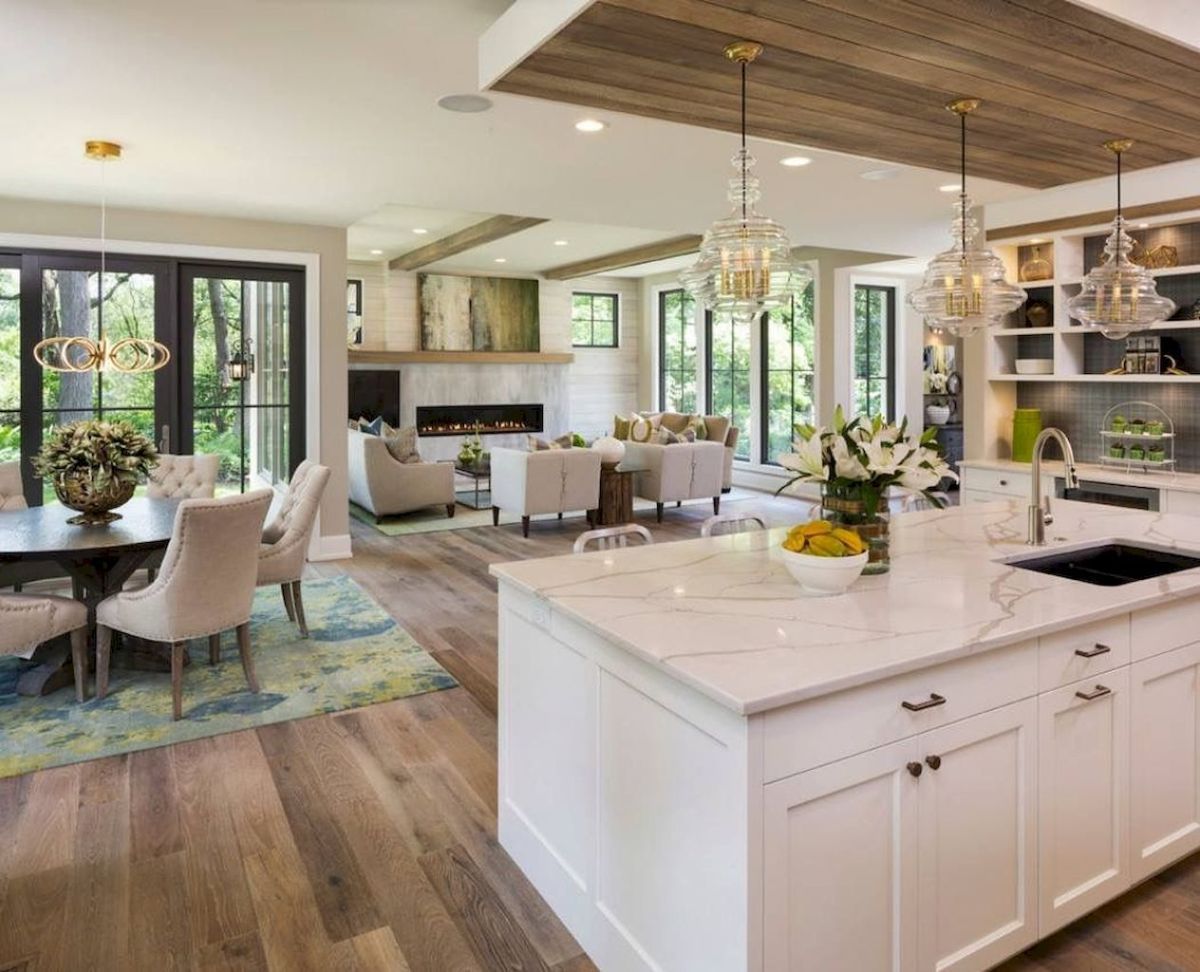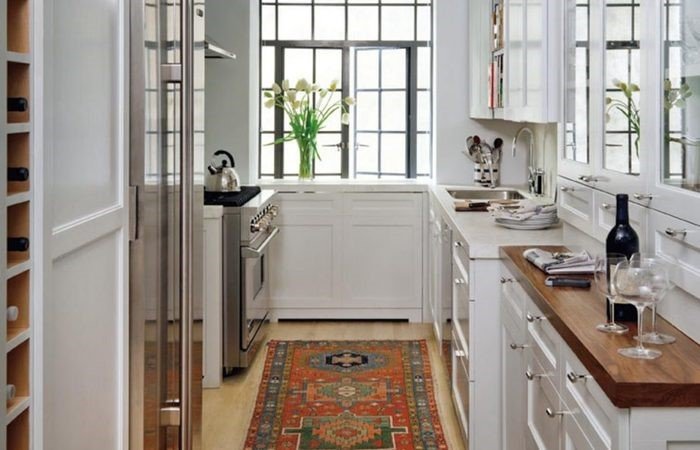Dreaming of a kitchen that’s both functional and charming? Imagine adding character to your space with simple farmhouse kitchen shelving crafted from recycled wood. Embracing the rustic appeal, these shelves bring warmth and authenticity to any modern dining room. But how do you achieve this effortlessly chic look without breaking the bank? In this post, we’ll explore the art of creating simple farmhouse kitchen shelving using recycled wood. We’ll delve into cost-effective yet stylish ways to revamp your kitchen while reducing environmental impact.
Key Takeaways
- Embrace the beauty and sustainability of reclaimed wood to add warmth and character to your farmhouse kitchen.
- Plan your farmhouse shelves carefully, considering the dimensions, weight capacity, and placement to achieve a functional and aesthetically pleasing design.
- Prepare recycled wood by cleaning, sanding, and treating it to ensure its suitability for shelving while maintaining its rustic charm.
- Construct rustic shelves using simple tools and techniques, such as basic carpentry skills and sturdy brackets, to achieve a farmhouse look with a touch of authenticity.
- Apply finishing touches, such as protective coatings or sealants, to recycled wood shelves for increased durability and resistance to moisture and wear.
- Style your shelves with a mix of practical storage and decorative items, such as vintage kitchenware and potted herbs, to create a cozy and inviting farmhouse ambiance.
Embracing Reclaimed Wood
Sustainability Benefits
Utilizing reclaimed wood for farmhouse kitchen shelving presents several sustainability benefits. By using recycled wood, the demand for new timber is reduced, contributing to forest conservation. Repurposing materials not only minimizes waste but also promotes eco-friendly practices by giving new life to old resources. Embracing sustainable options like reclaimed wood aligns with environmentally conscious living, supporting a greener and more responsible approach to home decor.
Reclaimed wood offers an array of aesthetic advantages that are particularly well-suited for farmhouse kitchens. The charming, rustic allure of recycled wood adds a unique character and warmth to the space, creating an inviting atmosphere. The natural patina of reclaimed wood further enhances its appeal, infusing the kitchen with a timeless and cozy ambiance that reflects the essence of farmhouse style. This type of shelving provides not just practical storage but also contributes significantly to the overall visual charm of the kitchen.
Material Selection
When opting for simple farmhouse kitchen shelving made from recycled wood, it’s crucial to consider material selection carefully. Weathered barn wood or salvaged lumber can enhance authenticity in design while adding historical significance to the space. These types of woods often bear marks and textures that tell stories of their previous use, enriching the visual appeal of the shelves.
In addition to appearance, choosing sturdy and durable lumber is essential for ensuring longevity and reliability in everyday use. Given that these shelves are meant for functional purposes as well as decorative ones, prioritizing non-toxic finishes is key in maintaining the organic appeal of reclaimed wood while safeguarding both environmental and human health.
Planning Your Farmhouse Shelves
Design Considerations
Incorporating open shelving in a farmhouse kitchen can create an airy and spacious ambiance, perfect for showcasing your rustic dinnerware or vintage pieces. Balancing functionality with visual appeal is crucial when designing farmhouse shelves. It’s about finding the sweet spot between practical storage and aesthetic charm. Embracing simplicity and minimalism complements the rustic charm of the shelves, allowing the natural beauty of the reclaimed wood to shine through.
Inviting space, using recycled wood for shelving can add character and uniqueness to your kitchen. The imperfections and weathered look of recycled wood bring a sense of history and authenticity to your farmhouse decor.
Measuring Space
Accurate measurements are essential for ensuring that your farmhouse shelves fit precisely into your kitchen space while optimizing wall utilization. When measuring space for your shelving, consider height, width, and depth to plan an efficient layout that meets both functional needs and aesthetic preferences. Measuring adjacent elements like cabinetry and appliances helps in integrating the shelves seamlessly into the overall design of your kitchen.
By using reclaimed wood for your farmhouse shelving project, you’re not only adding a touch of sustainability but also infusing warmth into your living space with its natural textures and tones.
Tools Required
To embark on this DIY project successfully, you’ll need several essential tools: a saw for cutting the wood according to measurements; a drill for assembling various components securely; a level to ensure straight alignment during installation; stud finder for locating sturdy support on walls; measuring tape for accurate dimensions; sandpaper or sander to smooth rough edges before assembly; clamps are handy tools that assist in securing pieces together during assembly processes.
Embracing sustainable practices by repurposing old barnwood or pallets as shelving material not only adds unique character but also reduces environmental impact by giving new life to discarded materials.
Preparing Recycled Wood
Cleaning Process
Regular dusting is essential to maintain the natural beauty of the reclaimed wood shelves. A simple solution of water and vinegar can effectively clean the wood without causing any damage. It’s important to avoid using harsh chemicals as they can compromise the integrity and appearance of the recycled wood.
When cleaning, it’s crucial to use a mild solution that won’t harm the wood but will still remove any dirt or grime. By avoiding harsh chemicals, you preserve not only the appearance but also ensure that no unwanted substances seep into your kitchen items.
Sanding Techniques
Sanding along the grain is key to achieving a smooth finish while retaining the character of the recycled wood. Start with coarse grit sandpaper and gradually progress to finer grit for optimal results. This process helps in removing splinters and rough spots, contributing to a polished and refined look for your farmhouse kitchen shelving.
Constructing Rustic Shelves
Cutting to Size
Precision cutting is essential when creating simple farmhouse kitchen shelving with recycled wood. It ensures that the pieces fit together seamlessly and results in a professional-looking outcome. By following measured markings, errors are minimized, and the recycled wood pieces can be utilized efficiently. Using a reliable saw with sharp blades guarantees clean and accurate cuts, which are crucial for achieving the desired shelf dimensions.
Organizing the components beforehand is key to streamlining the assembly process effectively. This allows for easy access to all necessary parts and prevents delays during construction. When assembling the shelves, aligning the pieces carefully before securing them ensures a snug fit for stability. Double-checking measurements during assembly is vital as it helps prevent misalignments or gaps between the wooden components.
Assembling Parts
When constructing rustic shelves using recycled wood, installing brackets securely is crucial for supporting the weight of loaded shelves. Properly secured brackets ensure that they can withstand heavy items without compromising safety or stability. Ensuring proper alignment of brackets maintains balance on walls and prevents any potential tilting or shifting of the installed shelves.
To reinforce the strength of mounted brackets, it’s important to use anchors or locate wall studs when attaching them to walls. Anchors provide additional support by distributing weight evenly across a larger area of drywall or plaster, while wall studs offer robust anchoring points for heavier loads.
Finishing Touches for Durability
Staining Options
Staining is a crucial step in the process of creating simple farmhouse kitchen shelving with recycled wood. It allows you to customize the color while preserving the natural texture of the wood. By applying multiple coats, you can intensify or deepen the hue based on your personal preference. For instance, if you want a darker finish, adding more coats will achieve that effect. Choosing water-based stains over oil-based options minimizes environmental impact, making it an eco-friendly choice.
When staining reclaimed wood for farmhouse shelving, consider using earthy tones such as chestnut or walnut to complement the rustic aesthetic. These warm colors enhance the natural beauty of the wood and blend seamlessly with farmhouse-style kitchens.
Protective Coatings
After staining, sealing your shelves with polyurethane or wax is essential to shield them from moisture and wear. These protective coatings not only enhance durability but also maintain the authentic appearance of your shelves. By regularly reapplying these coatings, you can prolong the lifespan of your simple farmhouse kitchen shelving, ensuring they withstand daily use and exposure to varying temperatures and humidity levels.
It’s important to note that polyurethane provides a harder finish compared to wax and offers better protection against scratches and heat damage. On the other hand, wax creates a soft sheen that adds warmth to reclaimed wood while still providing adequate protection.
Styling Your Shelves
Decor Themes
Integrating vintage kitchenware is essential. The nostalgic vibe of the farmhouse shelving can be complemented by displaying antique dishes, mugs, or utensils. These items not only add character but also evoke a sense of history and tradition within the space.
Another way to enhance the farmhouse aesthetic is by incorporating potted herbs or floral accents onto the shelves. This infusion of greenery and natural elements adds freshness and vitality to the kitchen decor, creating an inviting atmosphere that aligns with the rustic charm of farmhouse style.
Moreover, embracing neutral tones such as whites, creams, or light grays while adding pops of color through decorative pieces like ceramic jars or vibrant plates can harmonize perfectly with the overall rustic farmhouse aesthetics. This blend creates a visually appealing balance between simplicity and warmth in your kitchen space.
Functional Arrangement
In a simple farmhouse kitchen setting adorned with recycled wood shelving, grouping items by use or theme optimizes both practicality and visual appeal on the shelves. For instance, arranging baking essentials together on one shelf while placing everyday dinnerware on another facilitates easy access to frequently used items while maintaining an organized display.
Balancing storage needs with decorative elements is crucial for creating a functional yet stylish display on your farmhouse kitchen shelving. By strategically interspersing practical storage containers like woven baskets or glass jars amidst decorative items such as vintage cookbooks or ornamental pitchers, you achieve an equilibrium between functionality and aesthetic appeal.
Adjusting shelf heights according to specific requirements accommodates various items for convenient accessibility in your simple farmhouse kitchen setup featuring recycled wood shelving. Taller spaces might accommodate larger appliances like mixers or blenders while shorter sections are ideal for stacking plates or cups within easy reach.
Custom Shelving Solutions
Floating Variants
Floating shelves are a popular choice. These shelves offer versatility in placement, without bulky supports or visible brackets. By utilizing hidden bracket systems, these shelves maintain a seamless appearance on walls. This creates an illusion of space, contributing to an open feel in kitchens.
The beauty of using floating variants for your farmhouse kitchen shelving is that they can be placed at varying heights and distances from each other. This allows you to display items of different sizes and shapes creatively. For example, you can use them as a showcase for your collection of vintage mugs or heirloom plates while keeping the countertops clutter-free.
Floating variants also make it easier to access frequently used items like spices and cooking oils since there are no obstacles underneath the shelf. By placing these shelves near windows or doorways, natural light flows freely around them, adding warmth and brightness to the kitchen.
Industrial Combos
Incorporating metal brackets or piping into your simple farmhouse kitchen shelving can add an industrial touch that complements the rustic charm of reclaimed wood. The combination of reclaimed wood with metal elements adds contrast and visual interest to your kitchen decor.
Metal brackets not only provide sturdy support but also contribute to the overall aesthetic appeal by creating a striking juxtaposition between modern functionality and traditional design elements. For instance, you can pair rough-hewn wooden planks with sleek black metal brackets for a visually compelling look that exudes both strength and elegance.
Additional Farmhouse Projects
Coaster Crafting
Crafting coasters from leftover reclaimed wood pieces reduces material wastage. Personalized coasters add a unique touch to farmhouse kitchen decor. DIY coasters from recycled wood align with sustainable living practices.
Creating coasters from recycled wood is an excellent way to minimize waste and repurpose materials. By using reclaimed wood, you not only contribute to sustainability but also infuse a rustic charm into your farmhouse kitchen. These personalized coasters can be customized with initials, quotes, or patterns, adding a unique and personal touch to your kitchen decor.
Wall Paneling DIY
Repurposing reclaimed wood as wall paneling extends farmhouse aesthetics throughout the kitchen. Installing paneling provides texture, depth, and visual intrigue to kitchen walls. DIY wall paneling offers an affordable means to enhance farmhouse-inspired interiors.
Utilizing reclaimed wood for wall paneling allows you to bring the essence of the countryside into your home while reducing environmental impact. The natural textures and earthy tones of the recycled wood create a warm and inviting atmosphere in your farmhouse-style kitchen. Opting for DIY wall paneling presents a cost-effective approach to revamping your space without compromising on style or character.
Maintenance Tips for Longevity
Regular Cleaning
Routine dusting is essential to maintain the cleanliness of simple farmhouse kitchen shelving with recycled wood. Dusting not only keeps the shelves clean but also showcases the natural beauty of the recycled wood. Using gentle cleaning solutions, such as a mixture of mild soap and water, helps preserve both the appearance and integrity of the wood over time. By regularly cleaning the shelving, you can prevent dirt buildup, ensuring its long-lasting appeal in your farmhouse kitchen.
It’s crucial to keep in mind that simple maintenance routines can extend the lifespan of your farmhouse shelving by years. For example, wiping down wooden surfaces with a soft cloth dampened with water and mild detergent prevents grime from accumulating without causing damage to the wood. This regular care maintains an attractive look while avoiding potential issues like discoloration or warping.
Damage Prevention
To prevent scratches or marks on wooden surfaces, consider applying felt pads beneath items placed on your recycled wood shelves. These protective pads create a barrier between objects and the shelf surface, safeguarding it from potential damage caused by friction or movement. Avoiding excessive weight on shelves is vital for preserving their structural integrity over time.
Promptly addressing spills or moisture is another key aspect of maintaining simple farmhouse kitchen shelving with recycled wood. Wood is susceptible to warping when exposed to liquids for prolonged periods; thus, wiping up spills immediately helps prevent any potential damage to your cherished farmhouse furniture pieces.
Summary
You’ve learned how to transform simple farmhouse kitchen shelving with recycled wood into a stunning focal point. Embracing the character of reclaimed wood, you’ll plan, prepare, and construct rustic shelves that exude charm and functionality. Adding finishing touches for durability and styling your shelves will elevate the entire look. With custom shelving solutions and additional farmhouse projects, you can truly make your kitchen space unique. Don’t forget the maintenance tips for longevity to keep your shelves looking fabulous for years to come.
Now it’s time to roll up your sleeves and bring these ideas to life in your own kitchen. Get creative with your recycled wood, unleash your inner DIY enthusiast, and let the rustic charm of farmhouse shelving transform your space into something truly special.
Frequently Asked Questions
How can I ensure the reclaimed wood is safe for use in my kitchen?
Reclaimed wood can be safe for kitchen shelving if properly prepared. Sanding, cleaning, and sealing the wood will help remove any potential contaminants and make it suitable for use in your farmhouse kitchen.
What are some unique styling ideas for farmhouse shelves with recycled wood?
You can add a touch of rustic charm by incorporating mason jars, vintage tins, or woven baskets to hold utensils and spices. Consider mixing in some live plants or small herb pots to bring a fresh and natural element to your shelving.
Is it possible to customize the size and design of farmhouse shelves with recycled wood?
Absolutely! Customizing the dimensions and layout of your shelves allows you to perfectly fit them into your space. You could even incorporate hooks or small racks into the design for hanging items like mugs or towels.
How do I maintain the durability of my farmhouse shelves made from recycled wood?
Regularly applying a protective finish such as polyurethane will help guard against wear and tear. Wiping down the shelves with a mild soapy solution when needed will keep them looking their best while ensuring longevity.
Can I repurpose old wooden furniture into farmhouse kitchen shelving?
Certainly! Old wooden crates, ladders, or even salvaged doors can be creatively transformed into charming farmhouse shelving units. With a bit of ingenuity and DIY spirit, you can breathe new life into these discarded pieces while adding character to your kitchen.
